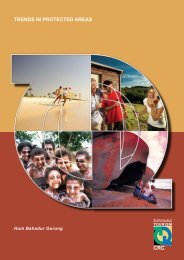icolls - Sustainable Tourism CRC
icolls - Sustainable Tourism CRC
icolls - Sustainable Tourism CRC
You also want an ePaper? Increase the reach of your titles
YUMPU automatically turns print PDFs into web optimized ePapers that Google loves.
ECOLOGY, THREATS AND MANAGEMENT OPTIONS FOR SMALL ESTUARIES AND ICOLLS<br />
Title of paper: Where estuary science meets estuary management: The role of scientific information in estuary<br />
management in south-eastern Australia<br />
Author: Melissa Thompson<br />
Author's email: mf63@uow.edu.au<br />
Abstract: Ecological services provided by the estuaries of south-eastern Australia are under increasing pressure<br />
from land use practices particularly rapid urban development. Calls to fill key data gaps and refine management<br />
and monitoring tools for these estuaries are intensifying. Just what data are needed to evaluate the condition of<br />
these complex systems is subject to ongoing debate. Three major estuarine management issues were used as case<br />
studies to analyse the role of science and the use of data in the estuary management decision-making process:<br />
firstly the artificial opening of ICOLLS, secondly the use of water quality indicators in assessing the health and<br />
sustainability of estuaries and thirdly biodiversity conservation. A lack of science and policy integration was<br />
revealed, leading to haphazard decision-making with little consequence for ecological outcomes. This was due to<br />
poor interaction between scientists and managers, and the absence of an appropriate framework to deal with<br />
specific management decisions. Despite the existing ecological database, decisions were based on short-term risk<br />
assessments of economic and social consequences while disregarding natural processes and long term<br />
sustainability of estuarine resources.<br />
Title of paper: South-Western Australian estuaries — Considering Ernest Hodgkin’s Swanland<br />
Author: Anne Brearley<br />
Author's email: abrear@cyllene.uwa.edu.au<br />
Abstract: The estuaries of south-western Australia are unusual because mostly winter river flow, rather than<br />
daily tides, bring changes in salinity. River flows in autumn/winter cause intense stratification with a layer of<br />
freshwater across the surface, which only breaks down as winter progresses. With the decreases in flow during<br />
spring, tides of small amplitude gradually move marine water upstream as a salt wedge along the bottom and the<br />
saline summer state is established. Breakdown of the winter and summer stratification depends on river flow,<br />
and wind mixing. In many of the estuaries bar formation is so extensive that the estuaries close when river flow<br />
is low and they may remain closed for months or even years. Opportunities for organisms to enter these estuaries<br />
are limited and conditions become stressful if the waters become hypersaline or dry out completely. These<br />
features were of great interest to Ernest Hodgkin (Hodge) and were central to his work on the evolution of the<br />
estuarine form and ecological processes. His ideas and research with many colleagues form the basis for current<br />
studies of estuaries in the southern hemisphere. Before his death in 1998 “Hodge” organised a bequest, The<br />
Ernest Hodgkin Trust for Estuary Education and Research “to provide funds necessary to write and publish an<br />
account of what is known about the estuaries of south-western Australia in an easily-read form for the general<br />
public. A major work — SWANLAND is now nearing completion, which provides a synthesis of Ernest<br />
Hodgkin’s work and thoughts, together with more recent research on the estuaries of south–west of Western<br />
Australia. The term SWANLAND was coined originally for the temperate region of the Western Australia<br />
receiving more than 10 inches (250 mm) of rainfall, roughly Shark Bay to Esperance. While the book and this<br />
presentation concentrate on the estuaries of SWANLAND, many principles of estuarine function and health are<br />
common to other regions with a micro-tidal coast and Mediterranean climate.<br />
Title of paper: An assessment of the impacts of anthropogenic influences on the dynamics of the temporarily<br />
open and closed Orange River Estuary<br />
Author: Lara van Niekerk, Susan Taljaard and Piet Huizinga<br />
Author's email: lvnieker@csir.co.za<br />
Abstract: In order to assist with the future water resources planning of South Africa and Namibia, a desktop<br />
study was conducted on the Instream Flow Requirements (called a preliminary Rapid Ecological Reserve<br />
Determination in South Africa) of the Orange River Estuary. In evaluating the freshwater requirements of a<br />
temporarily open/closed estuary, such as the Orange River Estuary, the two key drivers that influence the habitat<br />
and the associated biota of the system need to be considered, namely: 1) The frequency and duration of open and<br />
closed mouth conditions; and 2) The extent to which flow reduction has, or could, modify salinity penetration<br />
into the estuary. Hydrological data indicated that under natural conditions the mean annual runoff was 10 800<br />
x106 m3, which has been significantly reduced to 4 700 x106 m3 at present. An analyses of simulated monthly<br />
runoff data indicated that under natural conditions the estuary mouth used to close approximately one out of four<br />
years for about one month at a time. Under current conditions mouth closure seldom occurs, due to elevated base<br />
flows for hydropower generation in the winter dry season. Mouth closure is important, as it causes back flooding<br />
and inundation of the salt marsh areas, reducing soil salinities and allowing seed generation. The reduction in<br />
mouth closure events therefore has a significant impact on the habitat and health of the estuary. An evaluation of<br />
the relationship between the river inflow and the salinity regime of the estuary indicated that the system has been<br />
significantly modified from freshwater dominated for about nine months of the year under natural conditions, to<br />
63











